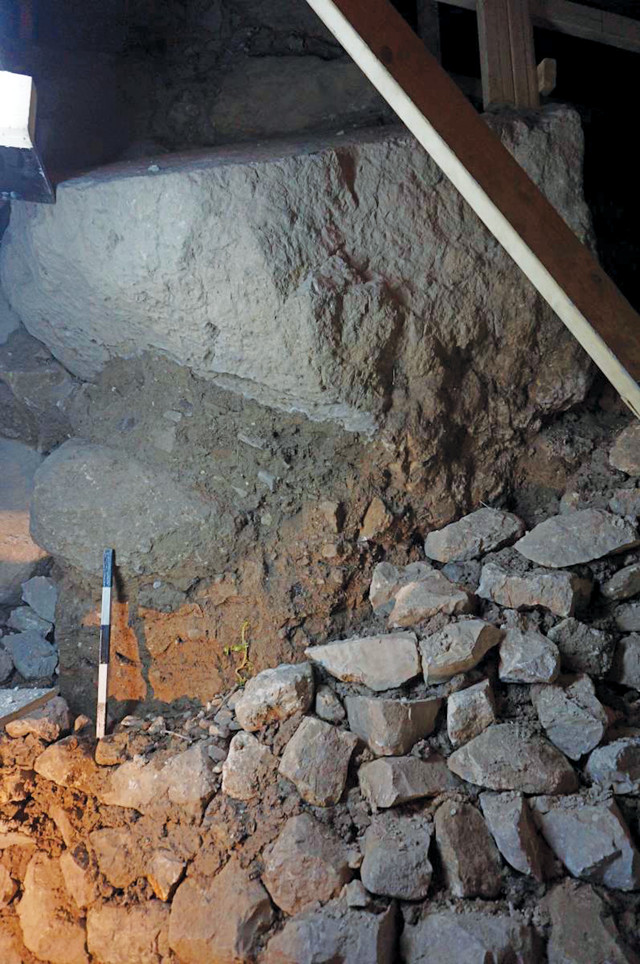
by Mary Caperton Morton Thursday, September 14, 2017

The base of the Spring Tower built to protect Jerusalem's Gihon Spring is 7 meters thick, constructed from boulders and sediment. Credit: Weizmann Institute of Science.
Jerusalem is one of the oldest cities in the world, dating back to at least 2400 B.C. Downhill from the heart of the city is Gihon Spring, a year-round natural fount that was likely the primary water source for the ancient city. Defensive fortifications built around the spring, known as the Spring Tower, were originally dated to the Middle Bronze Age, around 1700 B.C., but a new study reveals the tower could be as much as 1,000 years younger.
Jerusalem, located between the Dead Sea to the east and the Mediterranean Sea to the west, has had a tumultuous past, with the land long-contested on political and religious grounds. The city has been destroyed at least twice, besieged dozens of times and continuously rebuilt, creating many layers of history, the chronology of which can be difficult to pin down. Few studies have been done to determine absolute ages for buildings and other features in the city. “Jerusalem has been excavated many times, but the number of absolute radiocarbon dates we have for structures in the city can be counted on one hand,” says Elisabetta Boaretto, a nuclear physicist at the Weizmann Institute of Science in Israel and an author of the new study, published in the journal Radiocarbon.
As part of ongoing preservation and resealing of the Spring Tower, Boaretto and colleagues studied layers of sediments under the massive boulders that make up the 7-meter-thick base of the tower. The boulders themselves did not provide any datable samples, Boaretto says. “But underneath the boulders, the soil exhibits layering typical of archaeological strata, and these can reveal the latest date that the site was occupied before the tower was built.”
After carefully identifying and mapping the strata under the boulders, the team sifted microscopic bits of organic material from the layers for radiocarbon testing. The radiocarbon dates for the top layers of sediments, just under the boulders, revealed a surprise: Rather than dating to about 1700 B.C., the top layers were deposited between 900 and 800 B.C., suggesting the tower was constructed during the Iron Age.
“Instead of the Middle Bronze Age, we got a nice stratigraphic sequence that ended in the 9th century B.C., much later than we expected,” Boaretto says. Previously, the age of the tower had been established by dating fragments of ceramics found in the fill between boulders in the tower. But the fill used to build the tower may have been significantly older than the structure itself, Boaretto says.
The new study was “very meticulously done,” says David Ussishkin, an archaeologist at Tel Aviv University in Israel, who was not involved in the study. The new dates do not prove exactly when the tower was built, but rather set a maximum age for it. “The carbon dates say 9th century, but they are dating the layers beneath the foundation of the building. The building could have been built later, during the 8th century.”
The new dating affects the historical timeline for construction of the city’s walls and other fortifications, Boaretto says. “By changing the construction date of the tower, you change everything else that is related archaeologically and stratigraphically. It’s something of a domino effect.”
Ussishkin says he thinks the fortifications were built in the 8th century, well after the reign of King Solomon. “There is some resistance to this idea, that there were no fortifications at the time of King Solomon,” he says. “But this tower was not isolated, standing there by itself. It’s part of the fortifications of the city. If the tower was built later, then the fortifications must have been built later too.”
© 2008-2021. All rights reserved. Any copying, redistribution or retransmission of any of the contents of this service without the expressed written permission of the American Geosciences Institute is expressly prohibited. Click here for all copyright requests.